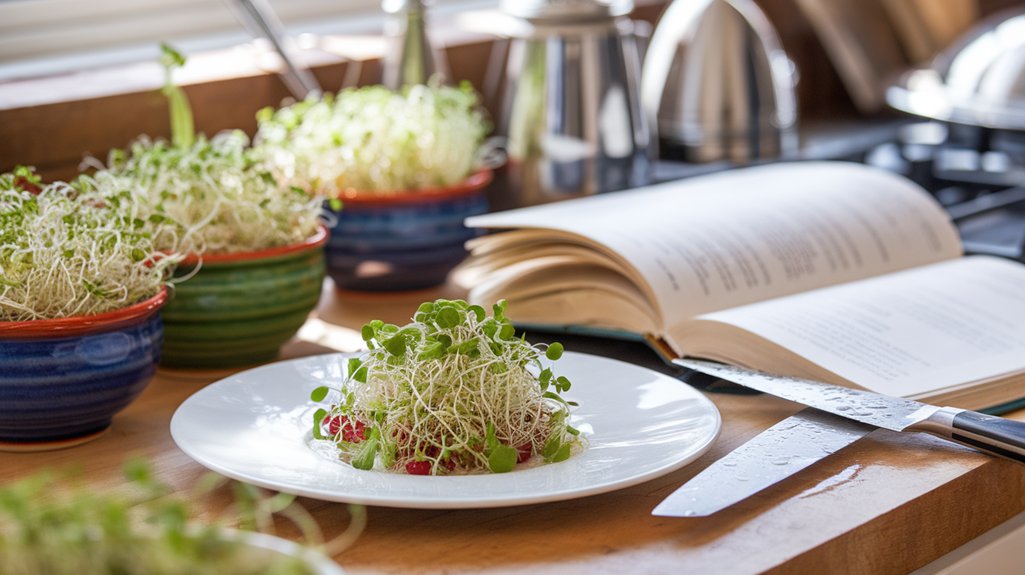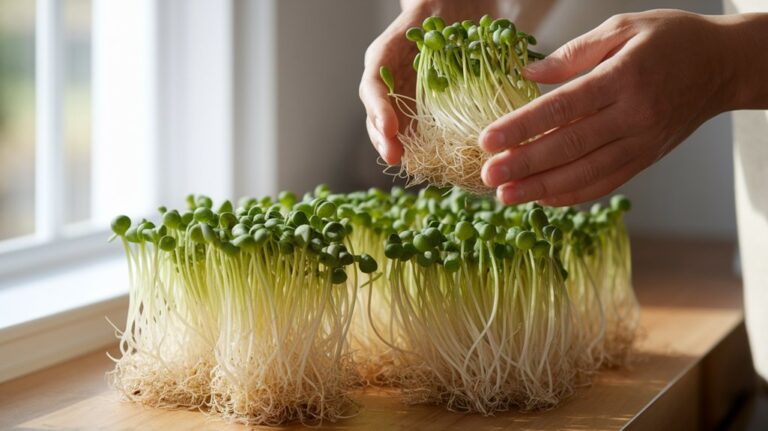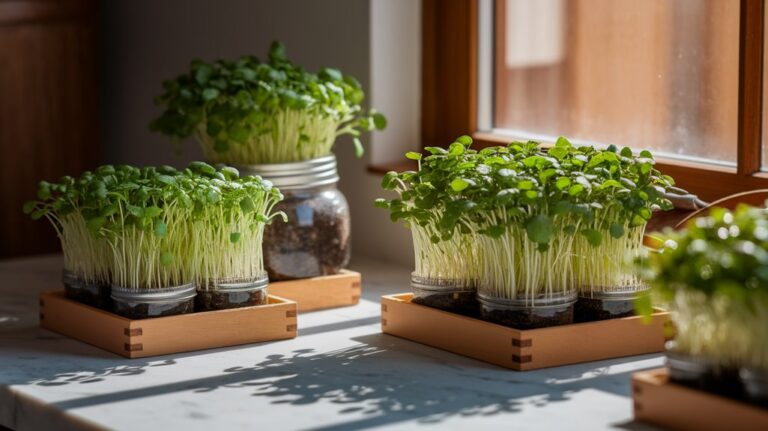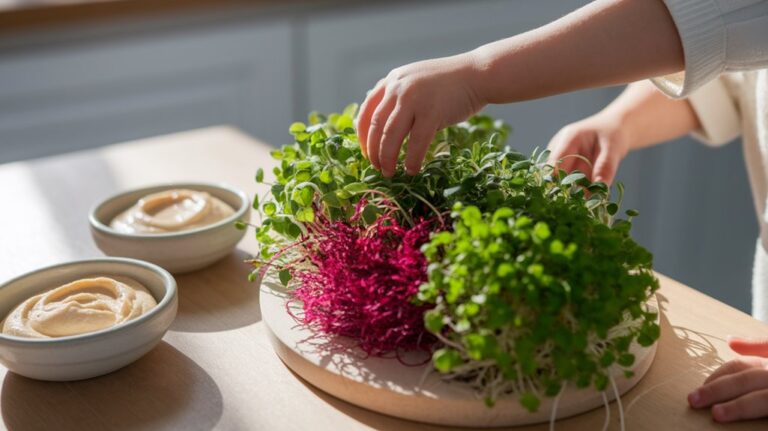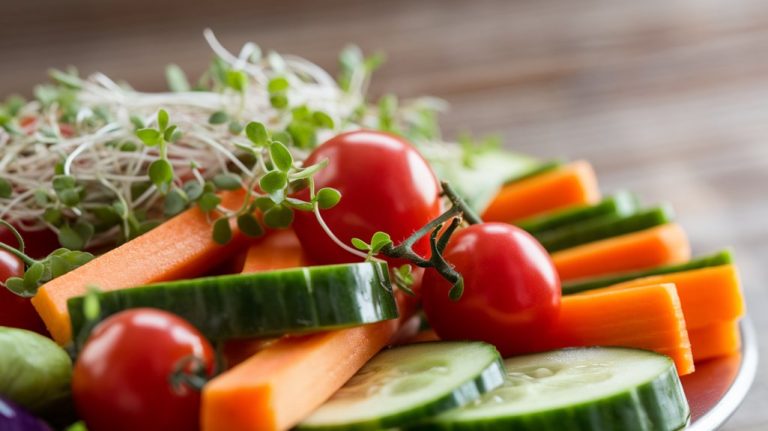Revolutionize Your Home Cooking With Fresh Sprouts
If you want to revolutionize your home cooking, fresh sprouts are the way to go! They’re packed with vitamins, minerals, and unique flavors that make any dish pop. I love adding crunchy alfalfa and zesty broccoli sprouts to my salads or using peppery radish sprouts in sandwiches. Not only do they boost nutrition, but they also add exciting textures to meals. Curious about how to grow your own or use them in recipes? There’s so much more to discover!
Key Takeaways
- Fresh sprouts are nutrient-dense, adding vitamins, minerals, and enzymes to enhance the health benefits of your meals.
- Incorporate various sprouts like alfalfa, broccoli, and mung beans for unique flavors and textures in your dishes.
- Use sprouts creatively in salads, sandwiches, stir-fries, or as garnishes to elevate your home cooking.
- Growing sprouts at home is simple and requires minimal equipment, making fresh ingredients easily accessible.
- Store sprouts properly in the refrigerator and consume within seven days for optimal freshness and flavor.
Understanding the Nutritional Power of Fresh Sprouts

When I first discovered the vibrant world of fresh sprouts, I was amazed by their nutritional punch packed into such tiny packages.
These little greens are bursting with vitamins, minerals, and enzymes that can elevate any dish. For instance, broccoli sprouts contain sulforaphane, a compound known for its cancer-fighting properties. Meanwhile, alfalfa sprouts offer a delicate crunch and are rich in vitamins A, C, and K.
I also learned that fresh sprouts are packed with protein and fiber, making them a great addition to my meals. Whether tossed in salads, blended into smoothies, or layered in sandwiches, they add both nutrition and flavor.
Incorporating fresh sprouts into my cooking has transformed my approach to healthy eating, making it exciting and delicious.
How to Grow Your Own Fresh Sprouts at Home
Growing my own fresh sprouts at home has been a rewarding experience that adds flavor and nutrition to my meals.
I’ll share how to choose the best sprout varieties, the essential equipment I use, and a simple step-by-step process to get you started.
With just a little effort, you can enjoy the crisp, vibrant taste of homegrown sprouts in no time!
Choosing Sprout Varieties
Selecting the right sprout varieties can make all the difference in your home gardening experience. I love experimenting with different types, and I’ve found that some varieties are more versatile in the kitchen than others.
Alfalfa sprouts are crunchy and mild, making them perfect for salads and sandwiches. Radish sprouts pack a peppery punch that livens up any dish. For a nutty flavor, I often reach for broccoli sprouts, which are also packed with nutrients.
If you’re looking for something unique, consider pea shoots; their sweetness is delightful in stir-fries or as a garnish. Take the time to explore these options, and you’ll discover endless possibilities to enhance your meals with fresh, homegrown goodness.
Sprouting Equipment Needed
To enjoy the vibrant flavors of fresh sprouts at home, having the right sprouting equipment is key. I recommend starting with a simple glass jar, which allows you to see the sprouts as they grow. A mesh lid or cheesecloth works wonders for drainage and air circulation.
You’ll also want a bowl to catch excess water when rinsing. If you’re feeling adventurous, consider investing in a dedicated sprouter—these often come with multiple layers for different varieties, making it easy to grow several types at once.
Lastly, don’t forget about a warm, dark spot in your kitchen; it’s essential for that perfect sprouting environment. With these tools, you’re ready to embark on your sprouting journey!
Step-by-Step Growing Process
While the process of growing your own fresh sprouts might seem intimidating at first, it’s actually quite simple and rewarding. I’ll walk you through the steps I follow to cultivate these nutritious gems at home.
- Soak the seeds: Start by soaking your chosen seeds in water for about 6-12 hours, depending on the variety.
- Rinse and drain: After soaking, rinse the seeds well and place them in your sprouting jar or tray. Ensure good drainage to prevent mold.
- Sprout: Keep the jar in a dark, warm spot, rinsing and draining them twice a day. In just a few days, you’ll witness the magic as tiny sprouts emerge!
With patience and care, you’ll soon enjoy a fresh harvest of sprouts!
Popular Types of Sprouts and Their Unique Benefits
When it comes to incorporating fresh sprouts into home cooking, a handful of popular varieties stand out for their unique benefits.
Alfalfa sprouts are a great source of vitamins A, C, and K, offering a crunchy texture that brightens salads.
Then there are broccoli sprouts, packed with sulforaphane, which is known for its cancer-fighting properties.
I can’t forget about radish sprouts; they bring a peppery kick and are rich in antioxidants.
Lastly, mung bean sprouts are versatile and rich in protein, perfect for stir-fries.
Each type carries its own flavor and health perks, making it easy to elevate any dish.
Exploring these sprouts not only enhances meals but also adds a nutritional boost I love.
Creative Ways to Incorporate Sprouts Into Your Meals
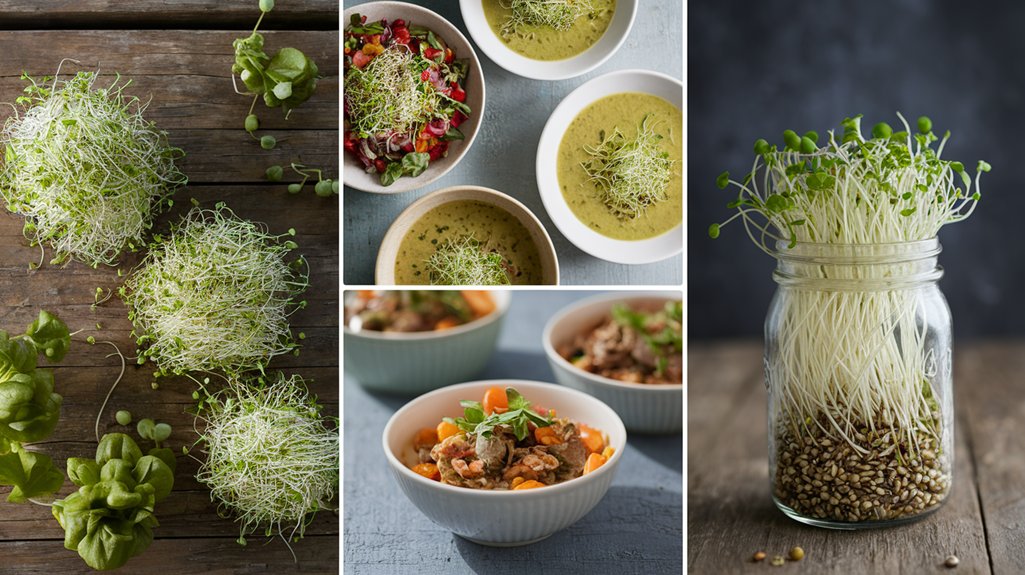
Incorporating fresh sprouts into my meals not only brings a burst of flavor but also adds a delightful crunch that elevates any dish.
I’ve discovered several creative ways to enjoy these little powerhouses of nutrition:
- Salads: Toss a handful of alfalfa or broccoli sprouts into your favorite salad for a fresh, zesty kick.
- Sandwiches: Layer radish sprouts in your sandwiches or wraps to replace lettuce and boost texture and taste.
- Stir-fries: Add mung bean sprouts at the end of cooking for a crunchy finish that complements the tender veggies.
These simple ideas make it easy to include sprouts in my daily meals, enhancing both flavor and nutrition effortlessly.
I can’t recommend it enough!
Delicious Recipes Featuring Fresh Sprouts
Fresh sprouts can transform ordinary meals into extraordinary culinary experiences, and I’ve got some delicious recipes that showcase their vibrant flavors and textures.
One of my favorites is a crunchy sprout salad with mixed greens, cherry tomatoes, and a zesty lemon vinaigrette. The fresh alfalfa sprouts add a delightful crunch that pairs beautifully with the tangy dressing.
Another go-to is a stir-fry featuring bean sprouts, bell peppers, and tofu tossed in a savory soy sauce. The sprouts soak up all that flavor, creating a mouthwatering dish.
Finally, don’t miss my avocado toast topped with radish sprouts and a sprinkle of sea salt—it’s simple yet bursting with freshness.
These recipes will surely elevate your home cooking!
Tips for Storing and Maintaining Fresh Sprouts
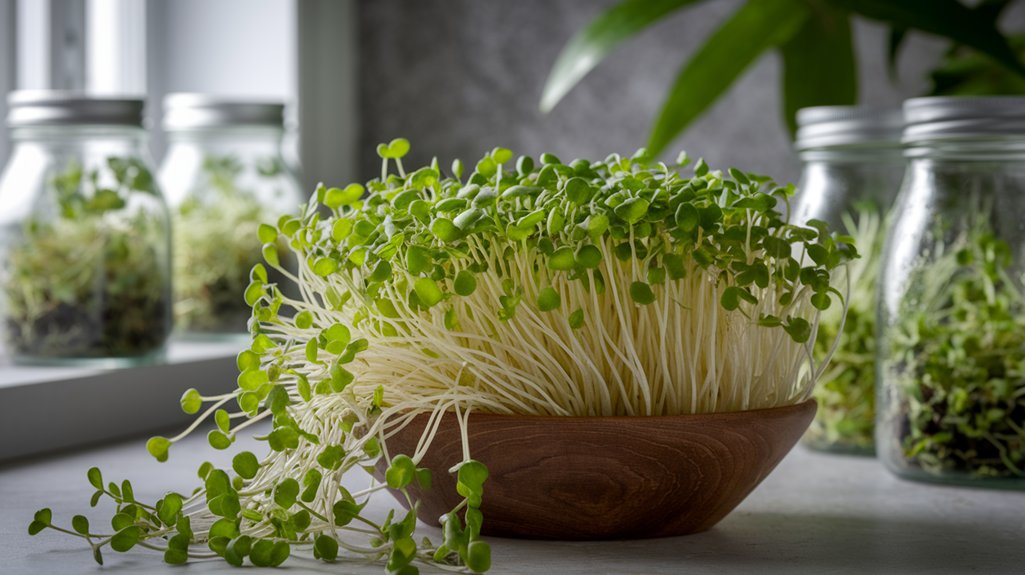
Although it might seem challenging to keep fresh sprouts thriving, with the right storage tips, you can enjoy their crispness and nutritional benefits for longer.
Here are my top tips for storing and maintaining your fresh sprouts:
- Keep Them Moist: Store sprouts in a breathable container, like a mesh bag or a paper towel, slightly dampened. This keeps them hydrated without promoting rot.
- Refrigerate Promptly: Immediately place your sprouts in the fridge after purchase. The cool environment slows down spoilage.
- Use Within a Week: Sprouts are best enjoyed fresh. Aim to consume them within seven days for optimal taste and nutrition.
Frequently Asked Questions
Can Sprouts Be Harmful if Consumed in Excess?
I’ve always loved adding sprouts to my meals, but I’ve wondered if they can be harmful in excess.
While they’re packed with nutrients, consuming too many can lead to digestive issues due to their high fiber content.
Additionally, sprouts can carry bacteria if not handled properly.
I’ve learned to enjoy them in moderation, savoring their crunch and flavor while keeping my health in check.
Balance is key to enjoying these little powerhouses safely!
How Long Do Fresh Sprouts Typically Last in the Refrigerator?
Fresh sprouts typically last about 5 to 7 days in the refrigerator if stored properly.
I always keep mine in a breathable container lined with a paper towel to absorb excess moisture.
It’s important to check them regularly for any signs of spoilage.
If I notice any sliminess or off smells, I toss them out.
Enjoying fresh sprouts at their best really makes a difference in flavor and nutrition!
Are There Any Allergens Associated With Specific Types of Sprouts?
Absolutely, I’ve found that certain sprouts can trigger allergies in some people.
For instance, alfalfa sprouts may cause reactions due to their amino acids, while soybean sprouts can be problematic for those with soy allergies.
I always recommend checking with a healthcare professional if you’re unsure.
It’s essential to be cautious, especially if you’ve got a history of food allergies, as everyone’s sensitivities can vary greatly.
Stay safe and enjoy experimenting with new flavors!
Can I Sprout Seeds From My Garden for Cooking?
Absolutely, you can sprout seeds from your garden for cooking! I’ve done it myself, and it’s a rewarding experience.
Just make sure the seeds are untreated and safe for sprouting. I usually soak them overnight, then rinse them a couple of times daily until they sprout.
Fresh sprouts add crunch and flavor to salads, sandwiches, and more. It’s a simple way to enhance your meals with homegrown goodness!
What Kitchen Tools Do I Need to Grow Sprouts?
To grow sprouts, I’ve found a few essential kitchen tools make the process smooth and enjoyable.
First, I use a sprouting jar, which allows for easy rinsing and drainage. A fine mesh lid is also helpful to keep seeds contained while letting air flow.
I’ve found a small bowl to catch excess water handy, too.
Finally, a warm, dark spot in my kitchen is crucial for germination.
Happy sprouting!
Conclusion
Incorporating fresh sprouts into my meals has truly transformed my cooking experience. Their vibrant flavors and incredible nutritional benefits make each dish pop with life and health. By growing my own sprouts, I’ve not only embraced a sustainable practice but also discovered a delightful variety of tastes. I encourage you to explore this exciting journey. Let your culinary creativity flourish, and watch how these tiny powerhouses can elevate your home cooking to new heights!

